|
At Atlanta, Georgia, in 1910, Robert D. Hickok, Sr., previously a watchmaker and jeweler, founded the Hickok Electrical Instrument Company.
With limited capital a small manufacturing building was established behind Mr. Hickok's home. One man was employed as assistant. Two types
of electrical instruments were built. They were large switchboard instruments similar to the present Model 12. Several other standard indicating
instruments were also built. Some of these instruments are still in use. Nearly everything was made by hand with simple machinery.
The year 1910 will be remembered by most people as the year of Halley's Comet.
But to Mr. Hickok and his family it will always be the year of the founding of
The Hickok Electrical Instrument Co.
The illustration commemorates both of these events, for it is a picture
taken by Mr. Hickok of his shop in his yard in Atlanta with Halley's Comet plainly visible over it.
|
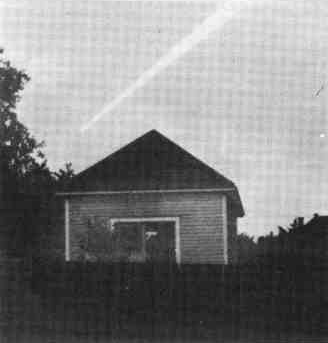
|
In the Spring of 1913, Mr. Hickok moved to Cleveland, Ohio to be closer to the electrical instrument market. Space was first rented at 6536
Carnegie Avenue, but in 1914 the Company moved to the present plant No. I site, at 10514 Dupont Avenue.
Even when there were only a few employees and Mr. Hickok was President, Chief Engineer and Sales Manager, the polices of the Company
as now, were based upon QUALITY of the product and keeping abreast of all possible new developments.
During the first World War the Company manufactured only indicating instruments of larger panel and switchboard types. Most of the instruments
then manufactured, were used on submarine destroyers, and some of the portable standard instruments made for the Navy at that time are still in use.
The years Immediately following World War I saw the development of Radio, which in its early beginning consisted of Spark Transmitting and crystal receivers.
About the year 1920 the three-element tube was invented by DeForest which gave, for the first time, amplification of Radio signals. and resulted to the development of a
transmitter and receiver to transmit and receive speech and music.
Mr. Hickok was among those who built a receiving set consisting of a Galena crystal connected thru a tuning coil, condenser and ear phone.
With the advent of the three element tube, Mr. Hickok built what was then a very elaborate receiver containing several stages of intermediate amplification and
it became immediately evident to him that apparatus would be needed to test these tubes.
This need resulted in Hickok's first dynamic mutual conductance radio tube tester, the B-47, which acording to the original Hickok history web page, only one was built.
Model B-47 - Early Hickok Mutual Conductance Radio Tube Tester for
battery and DC sets.
|
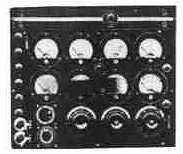
|
Unfortunately, the starting price tag of $350 - $400 (around $7,000 today) prohibited any sales of the B-47 and only one is known to have been produced.
It was held onto by the Hickok Electrical Instrument Company until the end of World War II when it was purchased from them at a company equipment surplus sale.
It is now in my possession and care. More information and photos will be posted shortly.
Since radio receiving sets began to come Into general use and required servicing, the Hickok Co. next put on the market their next tube tester that indicated Mutual Conductance,
known as Model SG 4600
(Illustrated below).
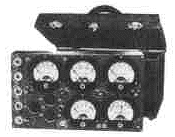
Hickok Model SG 4600 |
This tester did not read directly dynamic mutual conductance but did contain five meters to read plate and grid voltage, plate and grid current, and A.C. filament volts.
The mutual conductance was determined by reading the plate current at two different grid voltages. This instrument met instant popularity Among service men.
It was followed by Model SG 4700, which contained many improvements over the original model. The mutual conductance being read by changing the plate voltage
and grid voltage, and the result, the mutual conductance, being read directly from the DC plate milliammeter.
All the above tube testers were designed for sets which were plain battery or D.C. operated. Between 1924 and 1926 A.C. radio sets began to appear on the market.
To service them, Hickok put on the market the AC47, the first A.C. Dynamic Mutual Conductance Radio Tube Tester.
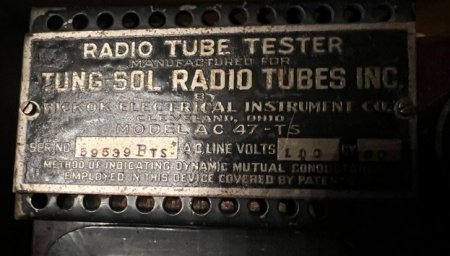
Hickok engineering continued to lead in radio tube tester design. Despite the depression years, 1929 to 1937, tube tester sales continued to increase
and more and more radio service men came to appreciate the value of the Hickok dynamic mutual conductance Tube tester.
In the early nineteen-twenties, a complete radio set tester was engineered and produced. This has since expanded into a complete line of radio
and television test equipment which is used by engineers and Radio-TV service men all over the world. Engineers and Radio service men look
upon Hickok meters and test equipment as the standard of quality because of advanced engineering design and high quality workmanship.
With this background of skill the Company decided in 1936, to manufacture several types of electrical aircraft instruments. The first electrical
aircraft instrument made was a resistance thermometer. With improvements, this instrument become the A.N. Universal type. The United States
Air Forces awarded Hickok the first large contract for these instruments. Hence, Hickok was the first quantity supplier of these meters to the air
forces. Hickok also manufacturers aircraft thermometers of thermocouple type for the Navy and supplies aircraft manufacturers with voltmeters, ammeters, etc.
In 1956 Hickok Inc. purchased Supreme Instruments Corp. The Hickok Inc-Supreme Electronics Div. still exists today in Greenwood Mississippi and
manufactures automobile test equipment. Steve's Supreme Instruments Collection
Early Hickok Test Equipment
MODEL AC 47 TUBE TESTER
With the appearance of AC operated radio receivers, which was brought about by the invention of radio tubes in which the filament would operate from AC
without producing a hum. R.D. Hickok Sr. began the work of developing a dynamic mutual conductance radio tube tester, which was likewise AC operated.
In the first model, the power to operate the tester was obtained from the radio receiving set itself the tubes to be tested being removed from the receiver and
the receiver connected to the tester by means of a cord and plug.
Model AC 47 - Display Cabinet
This instrument contained a meter reading directly in micro ohms and the plate voltage, grid voltage, plate current and grid current being read on suitable
voltmeters, milliammeters and microammeters. However, before this instrument was well on the market, a power pack was built in the tester itself (Model AC 47)
which delivered the necessary AC voltage to filaments and DC voltage to the plate, grid and screen.
|
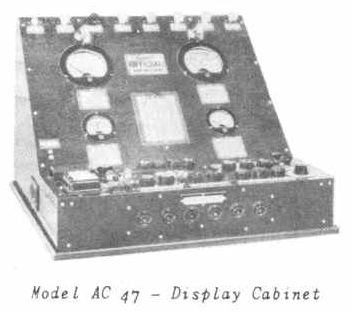 |
This was the first radio tube tester on the market containing its own power supply and
which read dynamic mutual conductance and in micro ohms: also, the plate current, grid current, plate voltage and grid voltage.
A patent was applied for and granted on the AC 47, and subsequent models using the circuit, which today is the most accurate method of measuring mutual
conductance yet devised. In fact, in our Mr. Barnhart's Radio Tube Laboratory, he uses a tester employing this circuit, made up in laboratory form for his primary
standard for tube characteristics.
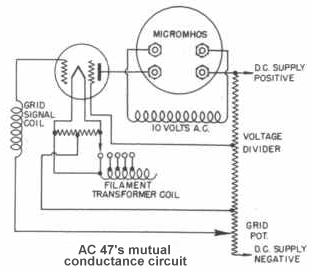 The AC 47 met instant favor with the radio service men and many thousands were sold.
Such tube companies as the Tung-Sol Co., the R.C.A. Radiotron Co.
and many others, adopted this tube tester and used it to assist in merchandising their tubes. This original AC 47 portable model was followed by the display
model, in which our model 44 meters were used - this model being particularly designed for stores to assist dealers in marketing radio tubes. See illustration
of this model tester in the large display model. The circuit all these testers employed was fundamentally as shown in the schematic wiring diagram Illustrated here.
The AC 47 met instant favor with the radio service men and many thousands were sold.
Such tube companies as the Tung-Sol Co., the R.C.A. Radiotron Co.
and many others, adopted this tube tester and used it to assist in merchandising their tubes. This original AC 47 portable model was followed by the display
model, in which our model 44 meters were used - this model being particularly designed for stores to assist dealers in marketing radio tubes. See illustration
of this model tester in the large display model. The circuit all these testers employed was fundamentally as shown in the schematic wiring diagram Illustrated here.
|
MORE RADIO INSTRUMENTS
(Webmaster's note: The next line contains what I think is a misprint. I think it should read "SG 4600 and AC 47" as discussed above)
With the development of the SG460 and AC4700 radio tube testers, R. D. Hickok simultaneously developed many other items of radio test equipment,
among them being the following:
The Portalab, The Compactalab, Model 4855 Volt-ohmmeter, The StatiKtester, Model 4647 Ohmmeter and Capacity Meter.
The development of these service tools for the radio service mann occurred between the years 1925 and 1935 and at that time, as well as at the present time,
HICKOK radio test equipment was in the forefront of such apparatus available to the service man and radio store.
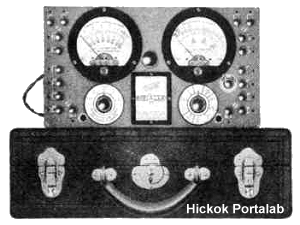 The Portalab illustrated on this page was a precision tool and met with large sale among the stores and radio service men, as it was the first portable
instrument to read with precision accuracy the following electrical units:
The Portalab illustrated on this page was a precision tool and met with large sale among the stores and radio service men, as it was the first portable
instrument to read with precision accuracy the following electrical units:
Resistance in all values from 0 to 30 megohms.
Capacity from .05 microfarads to 15 microfarads.
AC volts from 0 to 800 volts.
DC volts from 0 to 600 volts. Milliamperes from 0 to 300 milliamperes.
These were supplied in overlapping ranges, resulting in an instrument giving laboratory accuracy for all service requirements.
The Portalab employed our models 48, 4½" and 49M, 4½" A.C. meter - these models being brought out about 1925.
The scales on these meters were approximately twice the length previously employed in test apparatus for portable use.
The Portalab employed the same size case as its companion instrument, the AC47 radio tube tester and with these two instruments
the service man or store was fully equipped to service any type radio set. The Portalab was entirely self contained, the capacity meter
being operated from suitable transformers from standard to 110 volts AC supply line.
|

